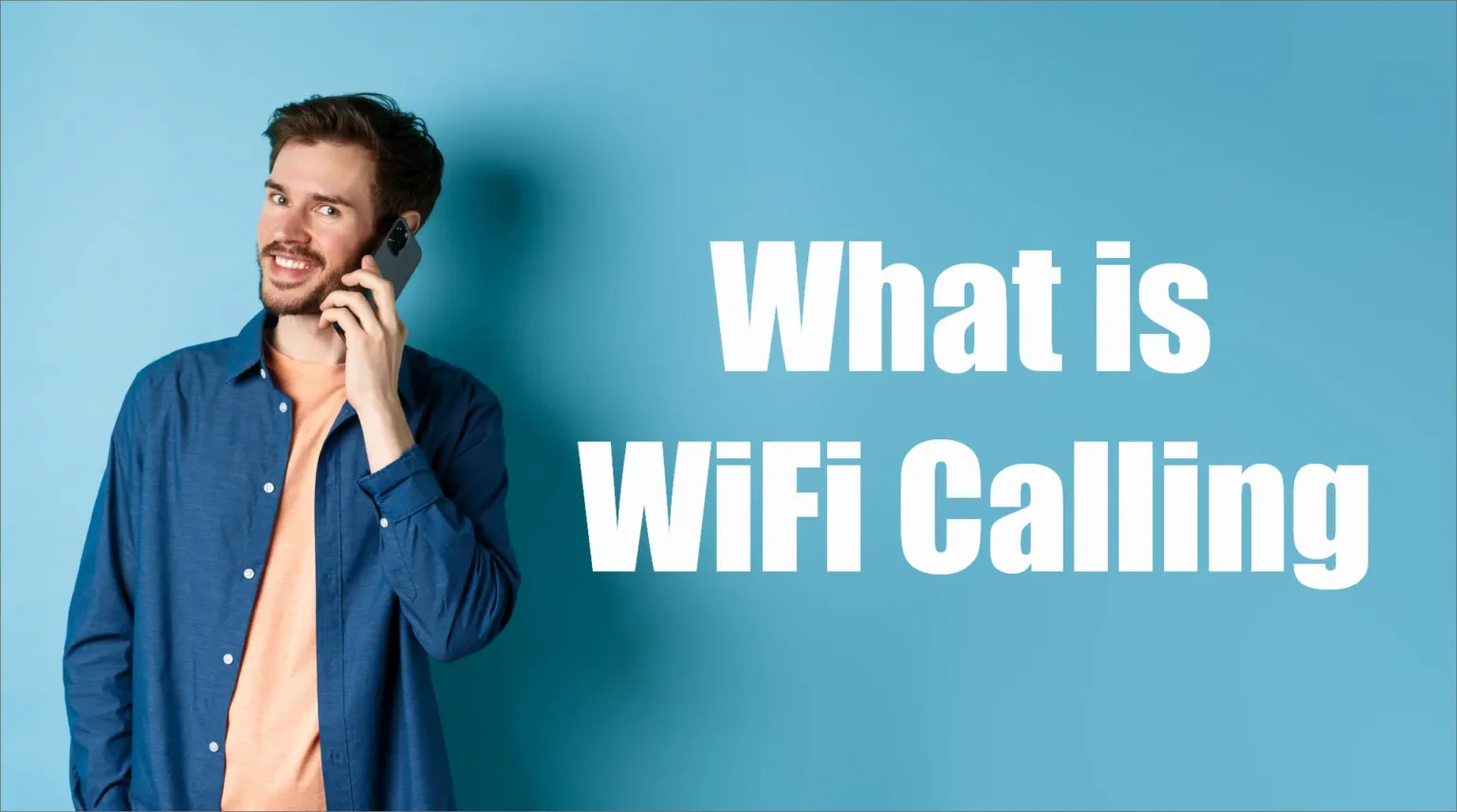In the past, using virtual communication tools was considered a threat to traditional telecom companies. But as technology progresses, staying connected has become as important as breathing.
One astonishing advancement in this direction is WiFi calling, a tech that lets us talk using the internet. If you are not sure what WiFi calling is, do not worry. We are going to explain it to you.
This technology has changed the game of how we communicate with each other. So, let’s dive in and discover what WiFi calling is, how it works, and why it is so beneficial.
What Is WiFi Calling?
From a user’s perspective, WiFi calling seems much like a regular phone call in which you dial a number just like you are used to, and all the familiar features like three-way calling and speakerphone work just fine.
The critical difference between regular and WiFi calls is how they travel. A regular call travels through old-school phone lines managed by traditional telecom companies, but WiFi calling detours through a WiFi network. We have all faced those moments when our phone signal goes all wonky, right? That is where WiFi calling shines. When your phone links with a wireless network, it becomes a handy alternative to patchy provider signals.
Considering using this internet-powered calling for your business, having a backup plan is brilliant. That way, if your primary connection decides to take a coffee break, you can still chat with clients and remote team members through your backup link. This high-tech way of communicating also comes in handy for businesses with teams spread out all over, ensuring everyone stays connected no matter where they are.
How Does WiFi Calling Work?
WiFi calling operates in a way that’s pretty similar to those VoIP apps you might be familiar with, like WhatsApp or Skype. Instead of relying on the traditional Voice over LTE network, it taps into Voice over Internet Protocol (VoIP). It means your spoken words get transformed into data packets and then transferred through the internet.
When you dial someone up, your gadget hooks into your WiFi signal and connects with your carrier’s particular server. From there, the call takes a virtual stroll over the web to reach the person you call. The whole deal happens behind the scenes, so it feels like a regular call to you.
But here’s the catch: for this magic to work on your smartphone, your device needs to be cool with this WiFi calling thing in the first place.
What Is The Difference Between WiFi Calling And VoIP?
You might have noticed that the “WiFi calling” option of your mobile device has become more prominent recently. Chances are, if you have ever made a call while connected to a network, you have already used WiFi calling. But despite its fancy name, the technology behind it, known as Voice over Internet Protocol (VoIP), has been around for quite some time.
VoIP might sound like a tech buzzword, but you have come across it more often than you realize in your personal life and at work. Think of popular apps like Skype, WhatsApp, Viber, Facebook Messenger, and Google Meet. These are all based on VoIP, and you can find many providers in the market.
The best thing about VoIP is that it is accessible, cost-effective, and reliable. It caught the attention of telecom companies, prompting them to use VoIP tech to create a new and competitive feature: “WiFi calling.” This feature works automatically on your smartphone when connected to a wireless network.
Here is the crucial difference: When we talk about VoIP, It usually means a separate app or platform you need to install. But when we mention WiFi calling, we are talking about a built-in feature with your phone, thanks to your carrier. No need to install anything extra. Just switch on a setting on your phone, and you are good to go.
How To Enable WiFi Calling?
Turning on and off WiFi calling depends on the type of device you are using :
If you have got an Android:
- Swipe down the notification panel and tap on the device settings.
- Look for “WiFi calling” using the search bar, or you might find it in the advanced part of your WiFi settings.
- Once you’ve found it, tap on “WiFi Calling” and slide that toggle switch to the “on” position.
For those rocking an Apple device:
- Open up the Settings app and find “Phone.”
- Inside “Phone,” you’ll spot “WiFi calling” – tap on it.
- Now, just toggle the switch to turn on WiFi calling.
Whether you are Team Android or Team Apple, both devices will ask you to punch in your address regarding emergency calls. If you ever need an emergency call, help can instantly find you.
What Are The Benefits Of WiFi Calling

WiFi calling offers numerous benefits to individuals and businesses. Some of these are as follows:
1. Backup For Weak Cellular Coverage
Imagine you are on an important call, and suddenly, your cellular signal drops. It will be frustrating, right? Well, that is where WiFi calling comes to the rescue.
It is like having a trusty backup plan for your phone calls. So, even if your regular cellular coverage gets a bit wonky, WiFi calls save the day.
2. No Need To Install Extra Apps
You might think using WiFi calling requires downloading yet another app, but here is the best part: it does not. You do not need to clutter your phone with more apps or software.
WiFi calling is like a hidden gem already tucked into your phone. So, no worries about eating up your phone’s memory or storage space.
3. Stronger Connection, Especially At Home
When you are at home, making a call using WiFi calling is like having a secret advantage. You are probably within about 50 feet of your WiFi router, which is a typical distance from one end of a small apartment to the other.
Compare that to the faraway cellular tower your phone usually connects to, which could be miles away. And if you live in a rural area, that tower might even be up to 80 kilometers away. So, your WiFi calling can give you a super reliable connection when chilling at home.
Disadvantages Of WiFi Calling
Along with the advantages, WiFi calling has some drawbacks you must consider:
i. Weak Signals In Public Places
Imagine you are at a café or a hotel, trying to make a call using WiFi calling. While it is fantastic for home use, things can get shaky when you are out and about.
Here is the scoop: where many people use the same WiFi network, like that café you are sitting in, there is only so much “internet juice” to go around.
When everyone sips from the same WiFi cup, your call might not sound as crystal clear as you would like.
ii. WiFi Hotspots Are Not Available Everywhere
Let’s talk about WiFi hotspots; these magical zones beam internet goodness. They have grown like crazy across the world.
But the thing is that you would not always find a hotspot hanging out wherever you go. So, relying solely on them for WiFi calling might not always be a good idea.
iii. Carrier-Branded WiFi Is Relatively New
Although VoIP tech has been around forever, cell phone carriers have only recently jumped on the WiFi calling bandwagon. Most prominent players offer this cool feature, but a few stragglers (in terms of carriers and older phone models) might not play nice with WiFi calling just yet.
Which Devices Support WiFi Calling?
Different phone companies have different rules about WiFi calling, like how you have different house rules for different games. Some carriers might let you use WiFi calling on specific gadgets but not others. So, even if your phone has the WiFi option, you can not enjoy WiFi calling when your carrier network does not support the device.
But do not worry; most leading network providers are on WiFi calling. Both Android and iPhone peeps can get in on the WiFi calling action. iPhones started getting the hang of it from the iPhone 5C onwards, and most Android gadgets are all about it, too. So, no matter which device you are using, you can enjoy the WiFi calling fun.
Final Words - WiFi Calling
WiFi calling is a game-changing technology that revolutionizes communication. It operates via wireless networks, rescuing calls from weak cellular coverage. With VoIP at its core, it effortlessly converts your Voice into data packets for seamless transmission.
WiFi calling is easy to activate on Android or Apple devices, acting as a backup for spotty signals and offering a reliable home connection. While it shines, especially indoors, it faces limitations in crowded spaces and hotspot availability.
Yet, it remains a vital tool embraced by carriers, seamlessly integrating into our communication landscape, regardless of device. It is the lifeline that transcends traditional networks, keeping us connected wherever we are.




